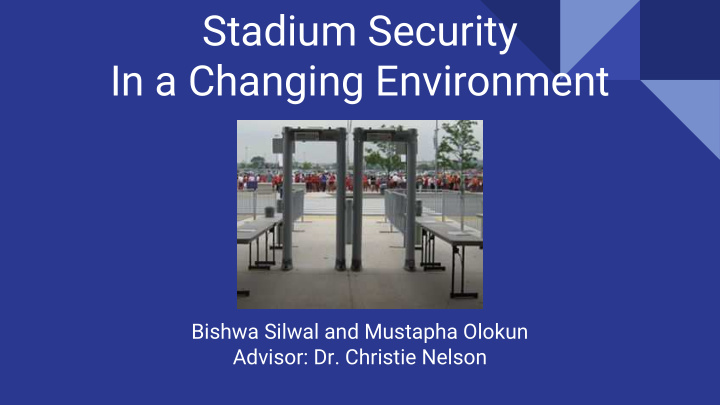



Stadium Security In a Changing Environment Bishwa Silwal and Mustapha Olokun Advisor: Dr. Christie Nelson
Background on Recent Stadium Terrorist Events Manchester Stadium (May 22, 2017) ● Explosive device concealed in a black vest or a backpack detonated after the concert ended Only a bag check was in place according to news reports ● Other screening methods were not used in this location at the time of the attack. ○ Photo credit: New York Times
Background on Recent Stadium Terrorist Events Paris attacks (November 13, 2015) ● Multiple coordinated attacks throughout Paris: soccer stadium, smaller concert hall, others. ● All attackers wore explosive vests at the large soccer venue Security was able to identify the first attacker, preventing him from entering. ○ ○ This deterred the other 2 attackers at that location. Istanbul (December 10, 2016) ● A car bomb was detonated outside Vodafone Area two hours after a soccer match ended. ● A Second explosive was detonated by the bomber wearing a suicide vest in an adjacent park. Both bombings targeted mainly police officials. ●
Our Project 1. Experiments on Walk Through Metal Detectors (WTMDs) 2. Data Collection and Analysis at a Live Stadium Event 3. Video Data Analysis from Stadium Event
Our Project: 1. Experiments on WTMDs 1. Make Representative Safe Metallic Vest Test Object(s) Test to see how well WTMD catch metallic Vest(s) at various ➔ security settings Photo Credit: ● Creating a test object representative of metallic vest(s) containing New York Times metallic objects (nuts, screws, nails) with different distributions/objects 2. Checking how human gait may impact WTMD detection of metallic objects Create heatmaps of vulnerabilities ● ● Test items to be used correspond to NILECJ 0601.00 standards for WTMDs (to meet a certain quality level) Photo Credit: Nelson, 2017
Literature Search Prior Work: Walk-Through Metal Detectors and Stadium Contraband (Nelson et al, 2016) Experiments on how multiple real stadium contraband used as test objects affected ○ detection. Performance of Walk-Through Metal Detectors against Curvilinear Motion (Nelson, 2017) ○ Experiments on how different walking pattern affected results of WTMDs Walk-Through Metal Detectors for Stadium Security (Nelson et al, 2016) ○ Experiments to discover potential vulnerabilities of WTMDs and observe their operation at large live events. Experimental Design: “An Experimental Design is the laying out of a detailed experimental plan in ● advance of doing the experiment.” (NIST, 2012)
Our Project: 2. Data Collection and Analysis ● Work with CCICADA Stadium Security Project Research Team Observe and collect data on WTMDs at MetLife at upcoming U2 concert ● Photo Credit: Metlife Stadium Website
Our Project: 3. Video Analysis If time and video footage made available: Compare data collection from video data versus human collection and ● analyze their differences Look for implications of Parkinson’s law in Security Screening at Stadiums ● (following a 2007 study of airport secur ity )
Acknowledgements We thank CCICADA/DIMACS for funding our project. We look forward to working with the CCICADA Stadium Security Research Team. We also look forward to working with the US Air Force visiting researchers. Our mentor Dr. Christie Nelson
References Chivers, C.J. “Found at the Scene in Manchester: Shrapnel, a Backpack and a Battery.” The New York Times. Arthur Ochs Sulzberger, Jr., 1 June 2017. Reuters “Turkey: Bombs Outside Soccer Stadium Kill 29 in Istanbul.” Newsweek. Dec 11, 2016 NIST/SEMATECH e-Handbook of Statistical Methods, http://www.itl.nist.gov/div898/handbook/pri/section1/pri1.htm. 2012. Nelson, Christie, Chaudhary, Vijay, Edman, John, Kantor, Paul. “Walk-Through Metal Detectors for Stadium Security.” Proc. of 2016 IEEE-HST Conference. May 2016. Waltham, MA. Nelson, Christie. “Performance of Walk-Through Metal Detectors against Curvilinear Motion.” Symposium on the Technologies and Metrology of CSE. April 2017. Toronto, ON, Canada. Nelson, Christie, Harris, Dexter, Eboreime, Omoikhefe. “Walk-through Metal Detectors and Stadium Contraband.” 2017 IEEE-HST Conference. Marin, Clara V., Drury, Colin G, Batta, Rajan, Lin, Li. “Human Factors Contributes to Queuing Theory: Parkinson’s Law and Security Screening” SAGE journals. 1 October 2007. Buffalo, NY. http://journals.sagepub.com/doi/abs/10.1177/154193120705101007
Recommend
More recommend